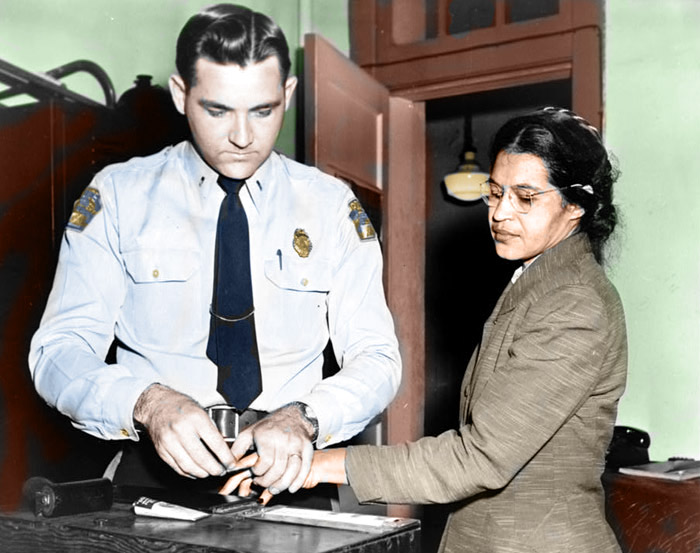SPARKY: REALLY IMPORTANT STUFF THAT WE MAY HAVE FORGOTTEN TO MENTION DUE TO "ROVE RAGE" — MEA CULPAApple did this piece on Rosa Parks which I'm enhancing a tad —
Rosa Louise Parks 1913 - 2005
Even to many people who were around in those days, the era of racial segregation seems as remote as the Civil War. You might say that back in the Fifties, American society lived at a different point in evolutionary time.

Social historians point to an individual act of defiance on December 1, 1955, as the beginning of the end of that time.
What happened: In Montgomery, Alabama, a black seamstress named Rosa Parks was heading home after a long day at work. She boarded a bus and found a vacant seat. Trouble was, if there weren’t enough seats on the bus for Caucasians, African Americans were supposed to give up their seats; back then that was the law in Montgomery, Alabama. As it happened, the bus soon filled up and Rosa was expected to give up her seat.
Fat chance. The lady had had enough. Rosa Parks refused to budge. In short order, Mrs. Parks was arrested, fingerprinted and fined for violating a city ordinance.
That incident in Montgomery turned out to be a catalyst for change. Mrs. Parks’s arrest resulted in a black boycott of the city’s bus line—a boycott that ended 381 days later when the bus line caved in, on the heels of a U.S. Supreme Court ruling that segregation in transportation was unconstitutional.
Meanwhile, the bus boycott triggered a wave of protest and freedom marches that captured national attention. The civil rights movement gathered momentum, and profound changes followed; Rosa Parks had rocked the country to its foundations. Perhaps more important, she challenged America to re-examine its values and institutions—and the country emerged that much stronger for it.

Angela Bassett as Rosa Parks
Learn more
Born Rosa Louise McCauley on February 4, 1913, in Tuskegee, Alabama, Parks was the first child of James and Leona Edwards McCauley; her brother Sylvester was born in 1915. The family later moved to Pine Level, Alabama, where Rosa grew up attending rural schools.
When Rosa completed her education at Pine Level at age 11, her mother enrolled her in Montgomery Industrial School for Girls. From there Rosa went on the Alabama State Teacher’s College High School, although her grandmother’s illness and subsequent death prevented her from graduating with the rest of her class.
Rosa married Raymond Parks in 1932. Raymond supported Rosa’s desire to complete her formal education, and she went on to receive her high school diploma in 1934. The couple worked together in the National Association for the Advancement of Colored People (NAACP) programs. Rosa became a secretary and later a youth leader of the local branch of the NAACP; she was preparing for a major youth conference at the time of her arrest.

The incident in Montgomery transformed Rosa Parks into a national figure and a major role model as well. She went on to work for U.S. Rep. John Conyers of Michigan. After Raymond’s death, she co-founded the Rosa and Raymond Parks Institute for Self Development. She also co-authored four books—”Rosa Parks: My Story” (with Jim Haskins), “Quiet Strength” (with Gregory J. Reed), “Dear Mrs. Parks: A Dialogue with Today’s Youth” (with Gregory J. Reed), and “I Am Rosa Parks” (with Jim Haskins).
Hundreds of American institutions paid tribute to this remarkable woman during her lifetime: Mrs. Parks received a number of honorary doctoral degrees, countless plaques, awards and citations, and keys to several cities. Among her honors were the NAACP’s Springarn Medal, the UAW’s Social Justice Award, the Martin Luther King Jr. Non-Violent Peace Prize, the Roger Joseph Prize from Hebrew Union College, and the Presidential Medal of Freedom.
Body of Rosa Parks to lie in honor at U.S. CapitolOctober 28, 2005The body of civil rights pioneer Rosa Parks, who died on Monday, will lie in honor at the U.S. Capitol Rotunda, a tribute usually reserved for deceased presidents and war heroes.
The Senate passed a resolution on Thursday for Parks to lay in the Rotunda on Sunday and Monday so that "the citizens of the United States may pay their last respects to this great American". The House of Representatives approved the resolution today.
Parks will be the first woman to be honored in this way.
Senate Majority leader Bill Frist said allowing Parks to lie at the Capitol is "a testament to the impact of her life on both our nation's history and future". Minority leader Harry Reid said that Parks' actions "changed not only our country, but the entire world, as her actions gave hope to every individual fighting for civil and human rights." Senator Christopher Dodd added that Parks "is not just a national hero, she is the embodiment of our social and human conscience and the spark that lit the flame of liberty and equality for African Americans and minority groups in this country and around the globe".
Meanwhile, officials in Montgomery, the place of her historic act of defiance, and Detroit, her later home and deathplace, ordered that the first seat of every public bus will be reserved to honor Parks until her funeral, which is set for Wednesday.
Sources
Tom Cruise parody site defiant in face of Scientology threats, demands its day in courtOctober 29, 2005

The Church of Scientology "cease and desist" order isssued last month to the New Zealand owner of a Tom Cruise parody website called scienTOMogy demanded they shut down the site, and transfer ownership to the Church, or face a lawsuit of up to $100,000.

The website responded on Saturday by stating, "Their claims are completely frivolous" and that "scienTOMogy.info is a parody site showing the recent lunacy of Tom Cruise - confusion of any kind with their site is literally impossible... We're keeping our domain... see you in court."
On September 14, the Church's law firm, Moxon & Kobrin, responded via email that the scienTOMogy website domain was an infringement of their trademark that would cause a "likelihood of confusion" with their own, and thereby broke federal law. Specifically, the Church cited the Lanham Act, 15 U.S.C. ? 1125(a).
The Lanham Act contains the federal statutes governing trademark law in the United States. The Church would have to prove factors such as "proof of actual confusion", "product types, proximity and marketing", "their respective appearance and meanings", and "(bad) intention behind selecting the mark"
Glen Stollery, the website's owner hit back at the Church by stating, "We have researched this and believe their claims are completely without merit. The church can provide no proof as to any confusion regarding the sites. For instance, scientology.info does not even exist, so compared to scienTOMogy.info it is hardly a matter of someone hitting the wrong key. We also have a Full Disclaimer at the top of the front page and in the website's meta-tags stating that there is no connection between ourselves and the church. Not to mention the fact that the site is completely non-commercial in nature, and does not generate a single cent of revenue nor offers any services of any kind. It is a parody site showing the recent lunacy of Tom Cruise - confusion of any kind with their site is literally impossible."
Stollery continues "The non-commercial use of a trademark as the domain name of a website — the subject of which is consumer commentary about the products and services represented by the mark — does not constitute infringement under the Lanham Act." Bosley Medical Institute v. Kremer (9th Cir., Apr. 4, 2005). In this instance, we are even one step further removed as their trademark is "scientology" not "scienTOMogy" Their claims are completely frivolous."
If this is the case then it would not be the first time the law firm would be found guilty of filing frivolous complaints. In 1994, Helena Kobrin of Moxon & Kobrin, counsel for the Church of Scientology, was ordered to pay sanctions in the total sum of $17,775 for filing a frivolous complaint in federal court. Stollery states on his website that he believes this is simply a way of "scaring any critics into instantly backing down at the prospect of costly lawsuits regardless of their innocence." In closing he says to the church "I'm calling your bluff. File your lawsuit we're keeping our domain... see you in court."
Previous related news
Sources
Japan likely to change law to allow female heirs to the throneOctober 26, 2005 Japanese media reported that Prime Minister Junichiro Koizumi suggested yesterday that the government would submit a draft to the Diet to rewrite the Imperial Household Act within the next year. This is in response to a board of experts who have been investigating the succession issue.
The experts' Board on the Imperial Household Act, personally appointed by the Prime Minister, reached an agreement on the issue that an Empress should be accepted. Implementation of their recommendations would mean that succession to the highest position in Japanese society would occur without a gender bias.
At the present time, the Japanese imperial household has no male member over the age of 20; present law only allows male descendants to ascend to the Chrysanthemum Throne. The proposed solution would put Princess Aiko, the sole child of Crown Prince Naruhito and Crown Princess Masako in place as the most likely to inherit the position of monarch, following behind would be Princess Sayako who will leave the Imperial Household due to her planned marriage with a commoner.
Present law in Japan defines the succession as favouring male children; the last time the country had an Empress was in 1771, when Empress Go-Sakuramachi abdicated to her nephew.
Despite the fact that there is precedent for an Empress, some scholars have suggested family members who previously broke ties with the recognised royal family following the end of World War II should be considered for the succession, opening up the field of candidates even more. The group of scholars proposing this solution have stressed that their solution is aimed at maintaining the tradition of a male heir.
Sources
Bush narrows choice to Supreme CourtOctober 30, 2005
Reuters is reporting that President Bush is expected to announce his choice to replace Sandra Day O'Connor to the Supreme Court on Monday.
The Chicago Tribune reports that President Bush narrowed his short list of Supreme Court nominees to two, with a possible third. The two top individuals in consideration are Judge Samuel Alito of New Jersey and Judge Michael Luttig of Virginia. Judge Priscilla Owen of Texas may remain as a third possibility. Reuters late Sunday also listed Appeals Court Judges Michael McConnell, Edith Jones and Alice Batchelder as possibly under consideration. CBS added that the list may include Appeals Court Judge Karen Williams and Michigan Supreme Court Justice Maura Corrigan.
The nominee, when and if confirmed, would succeed Justice Sandra Day O'Connor who announced her retirement in July. This latest nomination process was made necessary when Harriet Miers withdrew from consideration.
Since Congress returned from summer recess, there have been significant changes at the court. When Justice O'Connor originally announced her intention to retire, President Bush nominated Judge John Roberts to replace her. However, when Chief Justice Rehnquist died in September from thyroid cancer, Roberts became the replacement for the Chief Justice.
Both Alito and Luttig are viewed by many as staunch conservatives with strong qualifications. The debate over either conservative candidate is expected to be largely partisan, unlike the Harriet Miers nomination that was widely criticized by both legislative parties for her lack of judicial experience.
Samuel A. Alito, age 55, has served as a judge on the 3rd U.S. Circuit Court of Appeals in Philadelphia since 1990. J. Michael Luttig, age 51, has served as a judge on the 4th Circuit Court of Appeals in Richmond since 1991. Both were orginally nominated by President George Herbert Walker Bush.
Sources
Hunter S. Thompson obituary spawns "murder" theoryApril 4, 2005 
Hunter Stockton Thompson (1937-2005) Photo by Allen G. Arpadi
Hunter S. Thompson, the author of "Hey Rube: Blood Sport, the Bush Doctrine, and the Downward Spiral of Dumbness", once discussed on radio the possibility that he would be murdered to shut him up — and that it would be made to look like a suicide.
Paul William Roberts, a friend of Thompson and a well known travel writer, in an obituary played on this possibility for dramatic effect. Roberts related the fact that Thompson was working on a a story relating to the World Trade Center demolition, and did say he was going to be murdered, and that the murder would be identified as a suicide. Roberts says in the second paragraph that Thompson did, however, commit suicide, and was not murdered. [1]
Two years ago in January 2003, Thompson actually did give an interview on KDNK radio (Colorado) where he made a suggestion that he may be murdered to shut him up.
"Bush is really the evil one here and it is more than just him. We are the Nazis in this game and I don't like it. I am embarrassed and I am pissed off. I mean to say something. I think a lot of people in this country agree with me...we'll see what happens to me if I get my head cut off next week -- it is always unknown or bushy-haired strangers who commit suicide right afterwards with no witnesses," the writer said.
More confusion has arisen after a quote from one of the police officers investigating the death scene. Deputy Ron Ryan said there was a spent shell casing, but there was no cartridge in the firing chamber, as there should have been under normal circumstances. Sheriff’s officer DiSalvo confirmed this opinion; "I think a bullet from the magazine should have cycled into the chamber". This "single bullet" problem has led to speculation that Thompson was coerced into self-inflicting a gunshot wound, being given a gun with a single shot, perhaps accompanied by threats against his family.
Speculation arose that the gun used to kill Thompson could have been capable of a manual ammunition cycle, though as yet no support for this claim has been offered. DiSalvo said he hadn't checked the gun, but that the weapon could have been on a manual cycle that would have stopped the other cartridges from going into the chamber.
The spent slug was found in the stove's hood behind Hunter Thompson's body, investigators said.
Thompson died February 20. The county coroner ruled that Thompson's death was a suicide on February 21.
Other friends were not suprised at his death. "I wasn't surprised," said George Stranahan, a former owner of the Woody Creek Tavern, a favourite haunt of Thompson. "I never expected Hunter to die in a hospital bed with tubes coming out of him."
Neighbours have said how his broken leg had prevented him from leaving his house as often as he had liked to.
One neighbour and long-standing friend, Mike Cleverly, said Thompson was clearly hobbled by the broken leg. "Medically speaking, he's had a rotten year."
Related story
Sources - Paul W.Roberts "Pope in a prose convertible". Globe and Mail, February 26,2005
- "Blogosphere Xpose? From GannonGate to the Hunter Thompson 'Suicide'". ParaPolitics, February 27,2005
- Deborah Frazier and Jeff Kass "Son's shotgun tribute". Rocky Mountain News, March 2, 2005
- "Hunter S. Thompson (1937-2005) on the Iraq War & the Bush Presidency". Democracy Now, Feb 23, 2005
- various "Paul William Roberts". Wikipedia, viewed March 7, 2005
- ROBERT WELLER "Friends say Hunter S. Thompson was in pain from broken leg, wasn't one to die in hospital". AP, February 21, 2005
Retired U.S. vets sue Donald Rumsfeld for excessive service cutbacksMay 31, 2005
One thousand residents of the Defense Department-managed Armed Forces Retirement Home in Washington, D.C. filed a class-action lawsuit on May 24, asserting that the cut-backs in medical and dental services imposed by Secretary of Defense Donald Rumsfeld are illegal. The operating budget for the home was reduced from $63 million in 2004 to $58 million for 2005. The residents cite cuts in on-site X-ray, electrocardiogram, physical and dental services, and the closing of the home's main clinic and an on-site pharmacy.
Chief Financial Officer Steve McManus responded that the changes not only save money but also achieved improved efficiencies. "We're really trying to improve the benefits to our residents," he said.
Most of the home's costs are paid for by a trust fund and monthly fees paid by residents. By law, the Armed Forces Retirement Homes are required to fund, "on-site primary care, medical care and a continuum of long-term care services."
Sources
Okay - dazzle me with comments on my shallowness - Sparks










 Amtrak Train at the
Amtrak Train at the 










